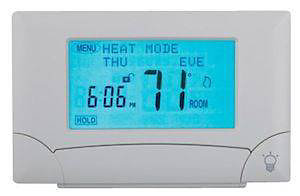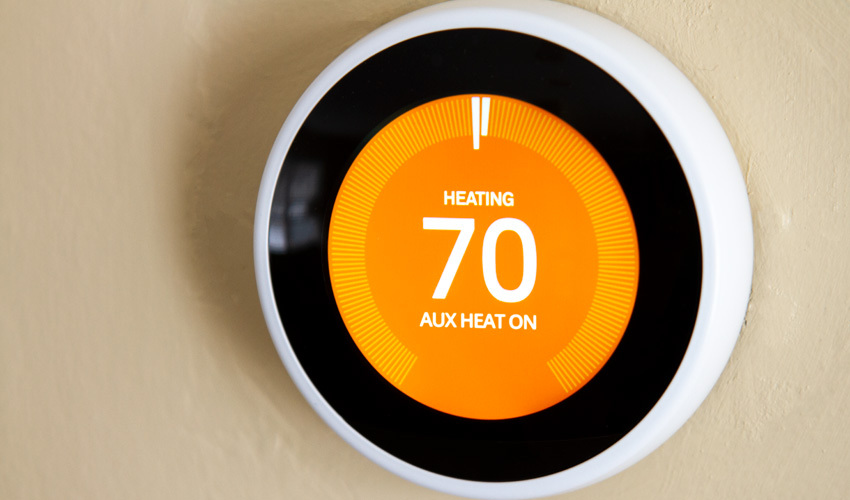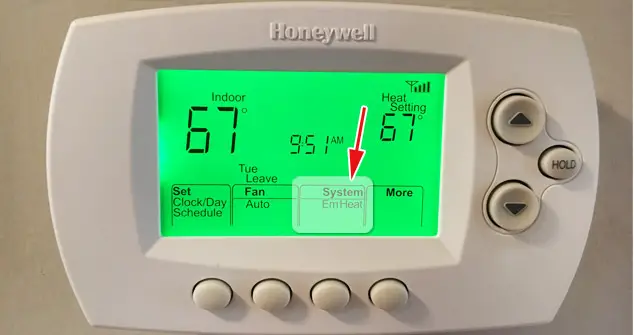Check Best Thermostat Pricing in Amazon
** As an Amazon Associate, I earn from qualifying purchases.
Emergency heat is a backup heating system. It activates when your primary heat fails.
Understanding emergency heat is crucial for homeowners. This feature helps maintain warmth in extreme cold. Your thermostat switches to emergency heat automatically or manually. It’s often used in heat pump systems. Knowing how it works can save you from chilly nights.
Emergency heat uses electric resistance or gas. It’s less efficient but necessary in emergencies. Learning about this feature ensures your home stays comfortable. Let’s explore how emergency heat functions and when to use it.

Credit: www.coolray.com
- Introduction To Emergency Heat
- How Emergency Heat Works
- Difference Between Emergency Heat And Regular Heat
- Benefits Of Using Emergency Heat
- When To Avoid Using Emergency Heat
- How To Activate Emergency Heat
- Troubleshooting Common Issues
- Professional Maintenance And Support
- Frequently Asked Questions
- Conclusion
Introduction To Emergency Heat
Have you ever noticed the “Emergency Heat” setting on your thermostat? This feature is crucial in certain situations. Understanding it can help you stay warm during unexpected cold snaps. Let’s delve into the details.
Purpose Of Emergency Heat
The Emergency Heat setting is a backup heating option. It activates the secondary heating source in your home. This usually means electric resistance heaters or gas furnaces. The primary purpose is to provide heat when the main heat pump fails. It ensures you have a reliable heat source during cold weather.
When To Use Emergency Heat
Emergency Heat should only be used in specific scenarios. Use it when the main heat pump is malfunctioning. It’s also helpful during extreme cold when the heat pump can’t keep up. Always switch back to normal mode once the primary system is fixed. This helps save energy and keeps your heating costs down.
How Emergency Heat Works
Emergency heat is a backup heating system on your thermostat. It activates when the main heat source fails. This feature ensures your home stays warm during extreme cold.
When winter hits and temperatures drop, you might wonder about the “Emergency Heat” setting on your thermostat. This feature is especially useful in extremely cold weather. But how does it work? Let’s break it down to understand better.Components Involved
Emergency heat systems are like backup plans. They include components such as a heat pump, auxiliary heat source, and thermostat controls. The heat pump is the primary component, usually efficient at heating your home. However, during freezing temperatures, it may struggle. That’s where the auxiliary heat source, often electric or gas, steps in. Your thermostat controls the entire system. It senses when the heat pump isn’t enough and activates the emergency heat. Imagine your thermostat is like the conductor of an orchestra, ensuring everything works harmoniously.System Activation
Activating emergency heat is straightforward. You’ll manually set your thermostat to “Emergency Heat” mode. When you do this, the thermostat bypasses the heat pump. Instead, it directly powers the auxiliary heat source. This ensures your home stays warm even when the heat pump can’t keep up. However, it’s important to use this mode wisely. Emergency heat is less efficient and more expensive. Think of it like using a spare tire: it’s there for emergencies, not for everyday use. Ever had a moment where you questioned why your heating bills were sky-high? It might have been because your emergency heat was running unnecessarily. So, knowing when and how to use it can save you money and keep your home comfortable. Next time you see “Emergency Heat” on your thermostat, you’ll know exactly what it means and how it works. Any questions about your thermostat’s settings? Feel free to ask.Difference Between Emergency Heat And Regular Heat
When winter hits, understanding the difference between emergency heat and regular heat can save you from a chilly night. You might wonder why your thermostat has an option for emergency heat. Knowing when and how to use it can make a big difference in your comfort and energy bills.
Heat Pump Operation
A heat pump is like a two-way street for temperature control. It can both heat and cool your home by moving heat from one place to another. During winter, it extracts heat from the outside air and brings it inside.
When temperatures drop below freezing, your heat pump might struggle to find enough heat outside. This is where backup heating sources come into play. Let’s dive into that next.
Backup Heating Sources
Emergency heat acts as a backup when your heat pump can’t keep up with the cold. It kicks in to provide heat directly, bypassing the pump. This is usually more expensive because it often relies on electric resistance heating.
Think of it like a safety net. You don’t use it every day, but it’s there when you need it. I remember a particularly harsh winter when my heat pump just couldn’t keep up. Switching to emergency heat kept my home warm, but I noticed a spike in my energy bill.
So, when should you use emergency heat? Only when your heat pump isn’t working or struggling to maintain a comfortable temperature. Using it all the time can lead to higher costs. Have you ever checked your energy usage after switching to emergency heat?
Understanding these differences helps you make smarter decisions about your heating system. Use regular heat whenever possible to save money and reserve emergency heat for those truly cold nights.

Credit: www.supertechhvac.com
Benefits Of Using Emergency Heat
Emergency heat on your thermostat can be a lifesaver during cold weather. It provides several important benefits that can make a big difference in your home’s comfort and safety. Understanding these benefits can help you make the most of this feature.
Ensuring Comfort
Emergency heat ensures your home stays warm during very cold weather. It acts as a backup system to your primary heating source. If your main heating system fails, emergency heat kicks in. This means you won’t be left shivering in the cold. It keeps your living space comfortable and cozy, no matter the temperature outside.
Preventing System Damage
Emergency heat can prevent damage to your heating system. It reduces the strain on your primary heat pump during extreme cold. Using emergency heat can prolong the life of your main heating system. It helps avoid costly repairs and replacements by taking over when the primary system is at risk of failing. This protective measure ensures your heating system remains in good condition.
When To Avoid Using Emergency Heat
Emergency heat can be a lifesaver in extreme weather conditions. However, it’s not always the best option. Let’s explore when you should avoid using it.
Potential Drawbacks
Emergency heat is designed for short-term use. Relying on it for extended periods can lead to higher energy bills.
It’s a backup system that uses electric resistance heating, which is less efficient than your regular heat pump. This means your home will warm up, but at a greater cost.
Additionally, frequent use can wear out the system quicker. You don’t want to find yourself needing a costly repair or replacement.
Energy Efficiency Concerns
Using emergency heat can significantly impact your home’s energy efficiency. Regular heat pumps are designed to be more energy-efficient by moving heat, rather than generating it.
Check Best Thermostat Pricing in Amazon
** As an Amazon Associate, I earn from qualifying purchases.
When you switch to emergency heat, you’re using a method that consumes more electricity. This leads to higher energy consumption and increased utility bills.
Consider the environmental impact too. Higher energy use means a larger carbon footprint. Is it worth the trade-off for a few extra degrees of warmth?
Instead, you can layer your clothing or use space heaters in occupied rooms. These small changes can make a big difference.
What steps will you take to avoid unnecessary use of emergency heat?
How To Activate Emergency Heat
Emergency heat on your thermostat is a backup heating system. Activate it by switching your thermostat to “Emergency Heat” mode. This feature helps when the main heat pump isn’t working properly.
Activating emergency heat on your thermostat can be crucial during extreme cold weather. This feature ensures your home stays warm when your primary heating system fails. Knowing how to activate it can save you from freezing temperatures and potential damage to your home.Thermostat Settings
First, familiarize yourself with your thermostat. Different models may have varying interfaces. Look for a switch or button labeled “Emergency Heat” or “EM Heat”. Most digital thermostats have a menu. Use the arrow keys to navigate. Select the emergency heat option. If your thermostat is older, consult the manual. It might have a different activation method.Manual Activation
Activating emergency heat manually is straightforward. Begin by locating the thermostat’s control panel. Switch the setting from “Heat” to “Emergency Heat”. This action will bypass your heat pump and directly engage the backup heating system. Be aware that using emergency heat can increase your energy bill. It’s powerful but not meant for long-term use. Have you ever wondered why it’s called emergency heat? It’s because it’s designed for those unexpected, urgent situations. So, use it wisely. Remember, regular maintenance of your heating system can prevent the need for emergency heat. But when you do need it, knowing how to activate it can be a lifesaver. Have you had to use emergency heat before? How did it go? Share your experience in the comments below.Troubleshooting Common Issues
Understanding how to troubleshoot common issues with your emergency heat setting can save you time and stress during the colder months. If your thermostat isn’t functioning as it should, it can lead to discomfort and higher energy bills. Let’s dive into some common problems and how to address them.
Thermostat Malfunctions
Your thermostat is the brain of your heating system. If it’s not working correctly, your emergency heat might not activate. Common signs of a malfunctioning thermostat include unresponsive buttons, incorrect temperature readings, and blank screens.
First, check if the thermostat is receiving power. Replace the batteries if it’s battery-operated. Ensure it’s properly connected to the wiring. If issues persist, consider resetting the thermostat by turning it off, waiting for a few minutes, and then turning it back on.
Sometimes, the thermostat might need reprogramming. Follow the user manual for specific instructions. If all else fails, it could be time for a replacement. A faulty thermostat can disrupt your entire heating system, so don’t hesitate to seek professional help if needed.
System Inefficiencies
Even if your thermostat is functioning well, your heating system might be inefficient. This can cause your emergency heat to run more frequently than necessary, leading to increased energy costs. Signs of inefficiency include unusual noises, uneven heating, and frequent cycling on and off.
Start by checking your air filters. Dirty filters can restrict airflow, making your system work harder. Replace them regularly to ensure optimal performance. Also, inspect the outdoor unit for debris or blockages. Clear any obstructions to improve airflow and efficiency.
Next, consider scheduling a professional maintenance check. A technician can identify and fix issues that might not be apparent. Regular maintenance can extend the life of your system and improve its efficiency. If your system is old and constantly having issues, it might be time to consider an upgrade.
Have you ever had to troubleshoot your emergency heat setting? What steps did you take to resolve the issue? Share your experiences and tips in the comments below!

Credit: www.aireserv.com
Professional Maintenance And Support
Professional maintenance ensures your emergency heat system works when needed. Regular inspections and timely support prevent unexpected issues. Your emergency heat system’s reliability improves with expert care.
Regular Inspections
Regular inspections keep your system in top condition. Professionals check for wear and tear. They clean and tune up components. Regular maintenance helps avoid costly repairs. It also extends your system’s life.
When To Call An Expert
Call an expert if your emergency heat doesn’t turn on. Strange noises or smells also signal a problem. Unusual temperature readings need professional attention. If your energy bills rise suddenly, call a professional. Don’t wait for small issues to grow bigger.
Frequently Asked Questions
Is It Okay To Run Emergency Heat?
Yes, it is okay to run emergency heat. Use it when your heat pump isn’t working properly.
When Should I Use The Emergency Heat Setting On My Thermostat?
Use the emergency heat setting when your heat pump fails or during extremely cold temperatures. This provides backup heat.
What Is The Difference Between Emergency Heat And Regular Heat?
Emergency heat uses a backup heat source when the primary system fails. Regular heat uses the main heating system.
Why Did My Heat Switch To Emergency Heat?
Your heat may switch to emergency heat if the main heating system fails or during extremely cold weather conditions.
Conclusion
Understanding emergency heat on your thermostat is crucial. It ensures your home stays warm. Use it only when necessary. Regular heating should be your primary source. Emergency heat can be costly. Always check your system’s settings. Consult a professional if unsure.
Keep your home comfortable and safe. Proper knowledge can prevent issues. Stay informed about your heating system. Make smart choices for home heating.
Check Best Thermostat Pricing in Amazon
** As an Amazon Associate, I earn from qualifying purchases.


